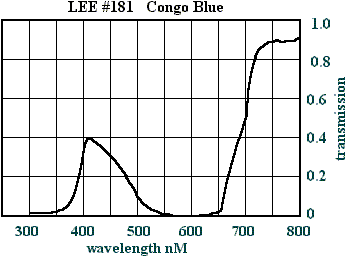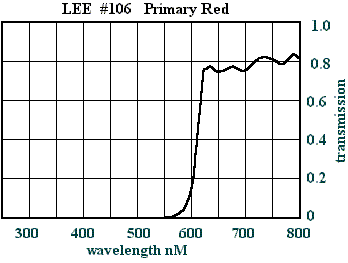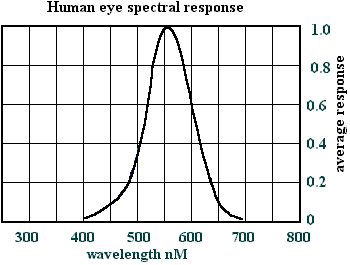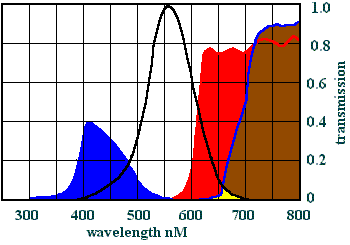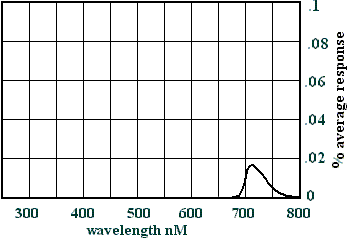http://www.leefilters.com/ LPFD.asp?PageID=2842. THAT'S NOT REALLY INFRARED!
http://www.rosco.com/ us/filters/protect.asp
Some people argue that, if humans can see it, then it must not be infrared
light. But this is wrong, or at least way oversimplified. Humans can see
750nM infrared. We can see 800, 900, even past 1000nM IR. The people
objecting to this have
a basic misunderstanding of bandpass filters. A bandpass will let through
all
frequencies: they cannot have infinitely sharp cutoffs and perfect
suppression of off-band signals. Check out the human sensitivity graph
below. The bandpass
graph has smooth slopes at the edges of the band. For signals on these
slopes, the light wavelengths farther from the passband must have higher
amplitude in order to be seen. The human visual system operates as a
bandpass filter with one edge usually taken to be at 700nM wavelength.
If light has frequency longer than 700nM, we name it "infra-red," and it
must be very bright in order
to become visible. For example, colleagues report that 900nM infrared
laser spots are easily visible in a dark room. (Unlike with bulbs and
with
IR LEDs, an
infrared laser emits no shorter wavelenghts which might be seen by human
eyes.)
In other words, there is no sharp division between "visible" and
"infrared." We can see light which is far outside the normal passband
called "visible frequencies." But that light must be intensely
bright. To see 800nM infrared, just make it 1000X brighter than
700nM visible red light. To see 900nM IR, make it a million times
brighter.
HVS curve to 1050nM. There's no
real border between IR and visible.
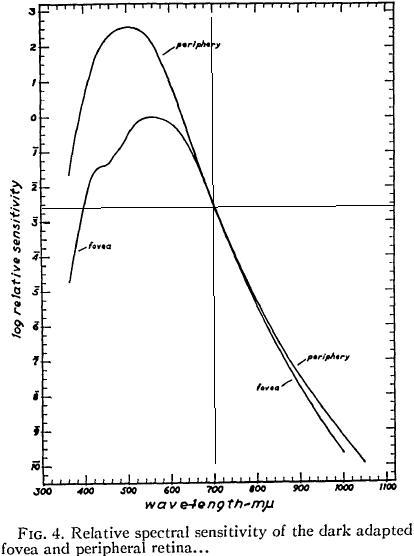
Above from "Sensitivity of the Human Eye to Infra-Red Radiation"
Griffin, Hubbard, & Wald, J. OSA V37 N7 pp546-554 (1947)
The real test of the
goggles is to analyze the problem numerically. Fortunately the
manufacturers of theatrical filters provide an absorption graph which can
be multiplied by the Human Visual System response in order to find the
sensitivity curve for eye-plus-filter. I did a crude graphical
multiplication using msExcel, and I find that three layers of Congo Blue
filter will shift the human eye peak response from 560nM green, pushing it
out to 720nM infrared. Adding more layers pushes it deeper into the IR.
Finally, when too many layers have been added, the goggles become useless.
At that point, the IR peak is around 735nM, and the outdoor scene looks
very strange, with light foliage beneath a black sky. Note that the HSV
curve is an average over population. That curve is fuzzy, so these
results are fuzzy too. Some people may see nothing through these goggles,
while others may see a very bright infrared scene.
3. THESE DON'T WORK AS NIGHT VISION!
Right. Notice that I said they only work in bright sunlight? They only
work in BRIGHT SUNLIGHT. How about bold italics: BRIGHT SUNLIGHT IS
REQUIRED. Night vision requires either a light amplifier, or it
employs an IR image-converter device, or silicon CCD video cam with an IR
floodlight.
Oh, now I understand. Some eBay scammers have copied my design, only
they're selling it as "night vision." They've added infrared LEDs to the
sides of the goggles. No, this is just a ripoff. Don't be a victim of
con artists. Other people have posted a "science project" that makes the
same bogus claim. If someone pretends that some LEDs and red/blue filters
can give you night vision, then that person is a hoaxer, and they're
hoping you're stupid enough to fall for it. Human eyes can see infrared,
but you'd need something to simulate daytime sunlight: several thousand
watts of IR spotlight. But then everyone would see it, with no goggles
needed. Duh, humans can see bright IR. Might as well use a visible red
spotlight. See, the whole idea is a bogus ripoff.
On the other hand, it's possible to alter a cheap webcam for IR use. See
many online DIY articles about removing the infrared-blocking filter from
your camera. (And use congo blue on your lens to block out the
visible light!) Or buy one of those $30 night vision security cams from
many web suppliers.
Then
you'll only need an IR floodlight or filtered flashlight (cheap,) as well
as a camcorder's viewfinder assembly or an LCD video display (expensive.)
If you want genuine military night vision, go buy a FLIR thermal camera on
eBay. They're sometimes as cheap as $1500-$2000.
3. CAN THESE SEE THROUGH CLOTHES?
No, but I think you really meant: "can these see through swimsuits?"
Certain
types of swimsuit are somewhat transparent out at 800-900 nanometers.
I've never tried this with the goggles, so you'll have to be the first.
Be sure to go to the beach wearing black goggles and an opaque Hoodie to
block the leakage, then stand motionless while staring at lots and lots of
swimsuits. Yeah, sure, nobody will call the cops on you. :)
On the other hand, what if you made some clothing out of congo blue
filter sheets? In bright sunlight while wearing the goggles, it would
appear halfway transparent. I wonder if you can find flexible
vinyl Congo Blue filters, instead of the crinckely mylar type.
4. ISN'T THIS DICYANIN DYE?
Yes, probably. WJ Kilner, and his goggles to view the human aura. But if
we actually read Kilner's work, we find that the goggles don't make auras
visible! Instead, we're supposed to wear the goggles for many hours or
days. This trains the eye, alters its behavior. Then take off the
goggles to see some strange things. Kilner also found that with some
people, after wearing the goggles for long enough, they no longer needed
to wear glasses to correct lens-errors. Another bit: the company
Infinity Jars is selling black glass containers which supposedly extend
the effective lifetime of TCM herbs, spices, etc. Far better than opaque
containers. I obtained one of these, and yes, it appears to be Congo
Blue dye in the glass. It's black for visible light, but passes both
violet and deep red! Hoffmann Lenses plus herbal matter: They Live!
NEXT: PHOTO GALLERY -->
